Dog aggression is one of the most common reasons pet parents seek professional behavioral help for their dogs.
Aggressive behavior may be characterized as a threatening and/or harmful behavior directed toward another dog, a human, or some other animal.
But it’s important to understand that there’s more to canine aggression that may be initially apparent.
For example, rather than seeking conflict, aggressive behaviors may be the result of your dog’s desire to avoid further acceleration of a conflict. Aggression can also stem from her own internal conflict or a conflict between her and another individual.
Dog aggression commonly includes body language that displays the intended threat, such as a hard stare, growling, barking, snarling, lunging, snapping, or biting.

These behaviors are not inherently wrong or bad (context is key), but they can certainly be problematic and it is important to seek professional help in order to keep everyone safe.
We’ll dive into the issue of canine aggression below, so you’ll have a better understanding of your dog’s behavior.
Fast Facts: Understanding Canine Aggression
- There are six signs of aggression that dogs can exhibit. This includes things ranging from barking to actual biting.
- You’ll typically need the help of a certified trainer or behaviorist to reduce your dog’s aggression, but there are a few management strategies you can implement that’ll help keep everyone safe in the interim.
- There are 11 basic types of canine aggression. By identifying your dog’s type of aggression, you and your trainer can implement an appropriate treatment strategy.
Signs of Aggression in Dogs: How Can You Tell If Your Dog Is Aggressive?
In most cases of dog aggression, the threat displays are emotionally driven. Often, aggression is rooted in fear and/or anxiety, making it reflexive rather than premeditated or malicious.
The six ways in which aggression can manifest are as follows:
1. Barking
Now, keep in mind that barking is a totally normal behavior for dogs and in fact, most barking has nothing to do with aggression at all.
Barking alone does not indicate aggression — it only indicates aggression when it is accompanied by another one of the signs listed below.
Additionally, dogs have different kinds of barks. I am sure most people can discern the difference between a high pitched ‘excited-you’re-home’ kind of bark to an ‘I-heard-a-strange-noise’ bark.
Aggressive barking is used as a threat, so it generally very loud, deep, and alarming.
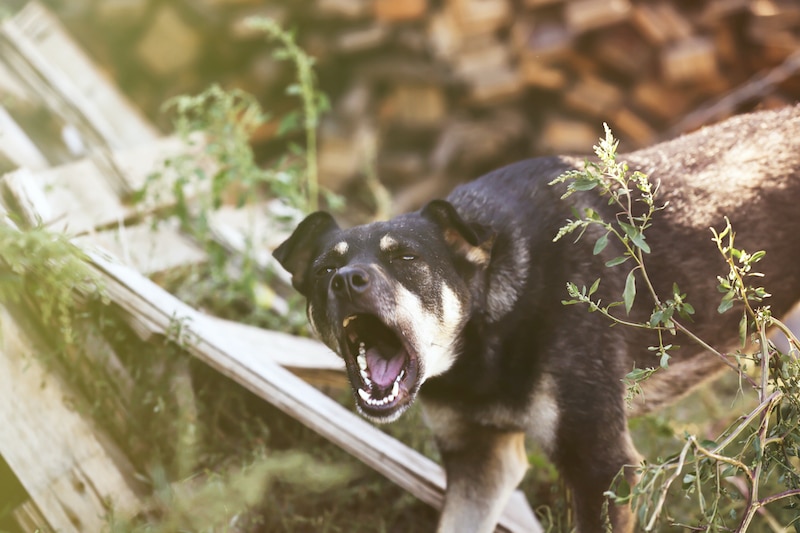
2. Growling
Most of the time a growl is simply a warning that your dog is uncomfortable with the situation she’s in or is faced with.
Growling is a very important mechanism that dogs use to communicate. Allowing your pooch to express herself when she is feeling stressed or uncomfortable is her right and should be respected. The growl gives us an opportunity to make her situation better and to mitigate any further escalation towards aggression.
Like barking — growling is not inherently aggressive. But when paired with barking, snarling, snapping or biting, it is.
3. Snarling
A snarl is a growl while baring teeth. Sometimes the snarl might be subtle — a low guttural utterance and a quick lip lift. Other times it carries more weight — an obvious and loud growl while showing off her full set of gnashers.
Both are serious warnings that should always be heeded.
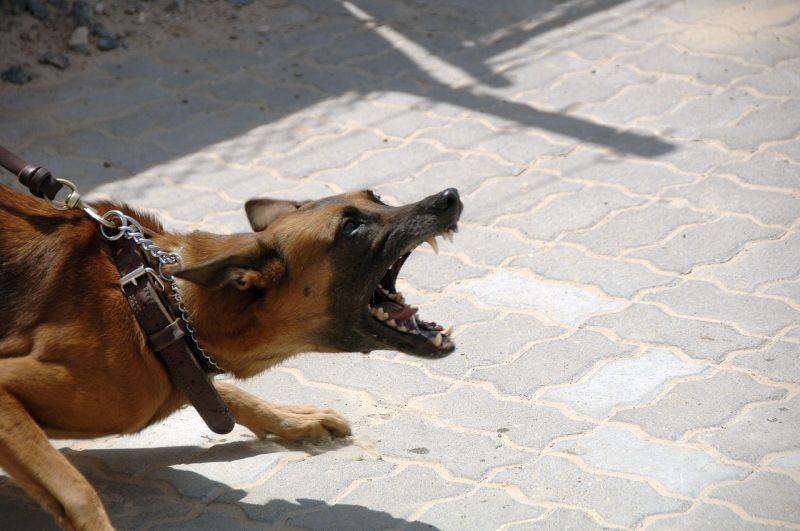
4. Lunging
Lunging is common for dogs who spot triggers from behind windows, fences or when restricted on a leash.
Some dogs who are off-leash may lunge towards their trigger and then retreat.
Lunging can give the false impression that your pup is brave when in reality, it can mean the opposite. She is trying to scare away the trigger that makes her feel nervous, scared, or insecure.
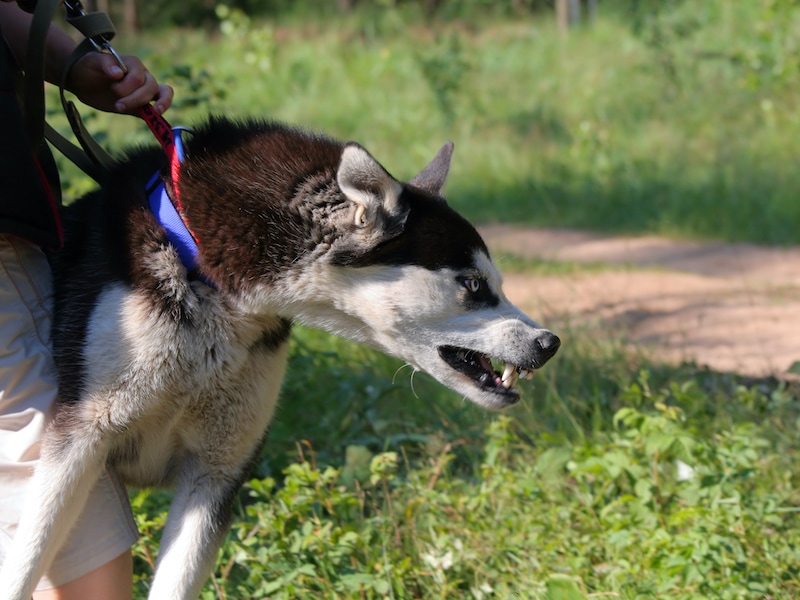
5. Snapping
Snapping is a form of biting that is directed towards a person or another animal, but it doesn’t include actual skin contact. It’s something akin to a ‘final warning’.
For instance, your dog may emit a growl or snarl followed by an “air snap” in your general direction.
This indicates that she’s not quite ready to use her last resort (biting), but she wants you to know it’s not off the table.
6. Biting
Biting can be as slight as a bit of tooth-on-skin contact, or it can be quite severe, causing punctures and broken skin. Some dogs may even shake their heads after biting or refuse to let go.
There is a commonly used scale outlining the severity of dog bites. The severity of the bite, as well as the frequency of the occurrence is important for assessing a dog’s level of aggression and the course of behavior modification and management needed.
This illustration from Dr. Sophia Yin helps explain the bite scale.

Pre-Bite Warning Signs
There are many subtle signs that may occur as a precursor to aggression.
Any dog can behave aggressively at any time she becomes fearful, scared or unwell. It is just as important to look at the more subtle warning signs that occur before she escalates to barking, lunging and growling.
These signals are often the first red flags when looking for signs of puppy aggression or what could blossom into aggressive behavior in adult dogs.
These could include:
- A rigid body and quickly wagging tail (short fast wags rather than broad relaxed wags)
- Lip licking or yawning
- Pinning or flattening her ears
- Avoiding eye contact, squinting or rapid blinking
- Raised hackles
- Cowering and tucking her tail
- Freezing, even if just momentarily
- Showing the whites of her eyes
- Hiding/shaking/running away
Note, however, that not all dogs who exhibit these subtle cues are or will behave aggressively. Many of these warning signs are also an indication of anxiety, fear, or stress.
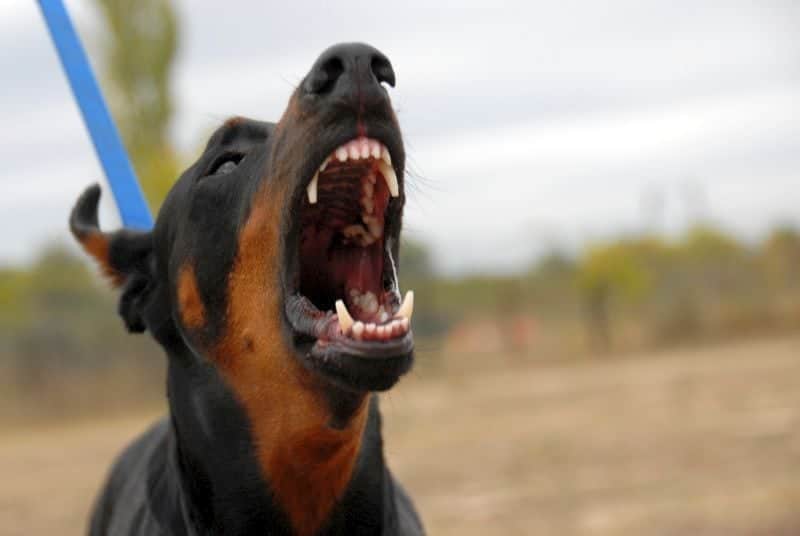
Can You Treat Dog Aggression Yourself?
First of all, the best way to treat your dog’s aggression will depend on the cause of the aggression. That’s why you should start by discussing aggression with your veterinarian and/or a Certified Dog Behavior Consultant (CDBC).
They can help you to uncover the root cause of your pup’s aggressive behavior and to tackle the cause rather than simply try to treat the symptoms.
Your veterinarian or a CDBC may refer you to a board-certified veterinary behaviorist depending on the situation and the severity of the aggressive behavior.
I don’t recommend tackling aggressive behaviors on your own. While we have so great tips for training an aggressive dog, a professional can help you to address the root cause or your pup’s aggression and start you on the right course of treatment.
It is important to note that there really is no ‘cure’ for aggression and treatment may be challenging. Often, a professional can help you to reduce the frequency or intensity of aggressive behaviors through training and management practices.
Your veterinarian may also suggest treating aggression with a combination of medications and behavioral and environmental modification that a board-certified veterinary behaviorist or CDBC can help you with.
While seeking professional help is advisable, there are some management tools that can help to keep you and others around your dog safe in the interim.
For example, try to avoid her triggers as best you can. Use leashes, pens, crates or baby gates when needed to keep her contained. And make sure you always supervise your dog, especially around children, as children are the most common bite victims according to dog bite statistics.
What Do You Do If Your Dog Suddenly Acts Aggressively?
Often, we know our dog’s triggers and we can avoid them. Mostly. But this is real life, and real life isn’t quite that perfect.
Sometimes you come around the corner and there is another dog running up to you off his leash. Other times, Aunt Edna shows up at your door unexpectedly.
So, what do you do if Fido suddenly becomes overly feisty?
- Turn around. If your dog is becoming aggressive while out for a walk, simply leave. Turn around, cross the street, head home or move to higher ground. If you are working too closely to the trigger, it will be increasingly more difficult to get your doggo’s attention. Stress hormones will flood her brain and she will have a hard time recovering from the incident.
- Redirect. Can you get her attention? If so, redirect her focus onto something else. Maybe it’s food, maybe a toy, a stick, or your attention. Anything that can redirect her focus away from the trigger and on to something more appropriate.
- Sooth her. Depending on what triggered your pup’s aggression, soothing a dog who is feeling fearful or anxious is never a bad thing. Because a fearful dog is reacting to her emotional state, you are not reinforcing her aggressive behaviors by being supportive and kind. It is important that she feels safe and supported by you in times that are stressful or scary.
- Keep everyone safe. If you need to separate yourself or others from your pup, do so. This might mean keeping your dog in another room, sequestering her behind pet gates, or confining her to a kennel.
- Advocate. If you know your pup isn’t keen on other dogs or people in her space, don’t be afraid to tell people to back off! If you have a hard time speaking on her behalf, try a muzzle. The muzzle often acts as a social signal for people to give you a wide berth, making managing her aggression easier.
- Prevent injuries. Maybe Fluffy isn’t a fan of Uncle Eddie, but Uncle Eddie is heading over to your house for a visit. Be prepared! You could use a muzzle (provided you have taken the appropriate steps beforehand to get her used to wearing it), or you could prepare food toys, and puzzles to keep her busy in another room.
- Avoid punishment. Punishing a dog for behaving aggressively is a sure-fire way to make things worse! Understanding and treating the root cause of your pup’s aggression will help her long-term. Punishing in the moment can scare your dogs and may actually increase aggressive behavior in the long run, according to science.
- Avoid physical manipulation. By this I mean, avoid picking your four-footer up or grabbing them away from the trigger unless it’s an emergency. Often this can result in redirecting her aggression onto the nearest person – you! It can also make your dog’s anxiety worse over time.
Being picked up means she has even more restrictions than just the leash alone and can exacerbate her fearfulness of the situation — in turn making her reactivity even worse.
Instead, try empowering her by teaching her some better coping mechanisms. A professional can help you achieve these goals through the use of proper behavior modification.

The 11 Most Common Types of Dog Aggression
Below, we’ll dive into 10 of the most common types of aggression dogs exhibit. Note that your dog may experience only one type of aggression, or she could experience several in combination.
1. Territorial Aggression
Territorial aggression is directed toward a person or another nonhuman animal that enters or approaches your pup’s ‘territory’.
This is usually observed in and around your house and yard or in your vehicle.
2. Possession Aggression
This type of aggression is also sometimes called resource guarding. This occurs when a dog feels threatened by another animal or person who comes near a valued item such as food or her toy. Possession aggression can be a common reason why a dog may show aggression towards other dogs in a home, even familiar ones.
She may become increasingly worried that her valued item will be taken away and will act defensively.
With mild cases of resource guarding, you may be able to simply manage your dog’s aggressive behavior by carefully picking up her valued items when they are not in use and not bothering her while she is eating or enjoying her resources.
However, if the issue is worrisome or has ever resulted in a bite, it is advisable to work with a professional to assist you with behavior modification.
3. Frustration-Elicited Aggression
Frustration can occur when your pup’s restricted on a leash or in a confined space, resulting in aggression or reactive behavior such as lunging, barking and growling.
When she becomes overly excited and can not act on her impulses, she may in-turn become frustrated and exhibit reactive aggression.
Sometimes, becoming overstimulated can have a similar effect, even when not restricted. For example, Rover might become so worked up about going for a walk that he nips at your hands as you’re trying to get his harness and leash on.

4. Redirected Aggression
This might occur when trying to manipulate your dog who is already acting aggressively towards another dog or trigger, with your dog’s aggression being redirected onto you!
For example, your pup might become aggressive toward you if you attempt to pick her up or break up a dog fight.
It may also happen when she is restricted and can’t get to the chihuahua on the other side of a fence or the cat across the street.
Redirected aggression is one of the most common ways owners can get bitten by their own dog.
5. Maternal Aggression
This occurs when a mom is protecting her puppies. It is important to handle new puppies to help them become accustomed to human interaction, so addressing mom’s aggression is imperative for the successful socialization of her pups.
6. Pain/Irritable Aggression
Pain, discomfort, or feeling unwell can cause aggression in some dogs. This is a pretty easy type of aggression to understand, as we’ve all felt irritable while under the weather.
If aggression is uncommon for your dog and the onset seems sudden or “out of the blue,” it’s best to have your veterinarian examine her and look for underlying medical issues.

7. Predatory Aggression
Predatory aggression occurs without much warning when the chain of predatory behavior begins.
This chain of events generally starts with stalking and ends with killing and sometimes consuming prey and is an instinctive pattern of behavior.
However, for a dog with a high prey drive, this instinct may become dangerous when directed towards children, small dogs, cats, or other pets.
Sometimes an innocent game of chase may trigger a predatory response, increasing the likelihood of a serious bite.
8. Social-Conflict Aggression
This type of aggression used to be referred to as dominance aggression. However, a more correct description would be aggression that is motivated by conflict in social context between two dogs.
Social-conflict is much more aptly named than dominance aggression because it can relate to any social interaction or conflict between any two or more individuals for a variety of reasons.

9. Sexual Aggression
This is less common in spayed or neutered dogs but can sometimes occur during mating behavior when there is competition with other males for female partners or between females for access to males.
10. Disease-Related Aggression
Some diseases may cause aggression in dogs. Rabies is a classic example of disease-related aggression. Other diseases that may predispose dogs to aggression are things like canine cognitive dysfunction (doggie dementia), epilepsy, hypothyroidism, among others.
Your vet can do a full blood panel to rule out diseases that may be the underlying cause of your pooch’s aggressive behavior. Some of these diseases are even treatable or manageable resulting in resolved aggression.
11. Fear/Anxiety Aggression
Fear and anxiety are the leading reasons that dogs will behave aggressively.
In reality, most types of aggression listed above likely have a fear- or anxiety-based component, with the exception of predatory and disease-related aggression.
Fear or anxiety aggression is often misinterpreted by most pup parents because the offensive body language, such as barking and lunging, looks quite confrontational and brazen. However, this behavior often comes from stress and anxiety.
You can reduce your dog’s fear and help them gain confidence through patience, careful exercises, and working with a professional trainer.

In rare cases, aggression can be idiopathic, meaning of unknown origin.
It doesn’t mean that there isn’t something driving the aggression, it just means that the cause is unknown. And without being able to pinpoint your dog’s triggers or the root cause, it can feel as though the aggression is occurring out of the blue and can feel unpredictable.
At one point in time, this was referred to as dog rage syndrome or dog rage disorder. But these terms are archaic, obsolete, and not helpful. Accordingly, in modern times, we simply refer to this as idiopathic aggression.
***
Aggressive behavior, particularly if the aggression has ever escalated to a bite, should be addressed by your veterinarian and a professional dog behavior consultant.
It can feel scary, but there is a lot we can do to better understand why our dogs are behaving the way they are and how to best help them.
Do you have a dog who has been aggressive at some point? How did you handle the situation? We would love to hear your stories.
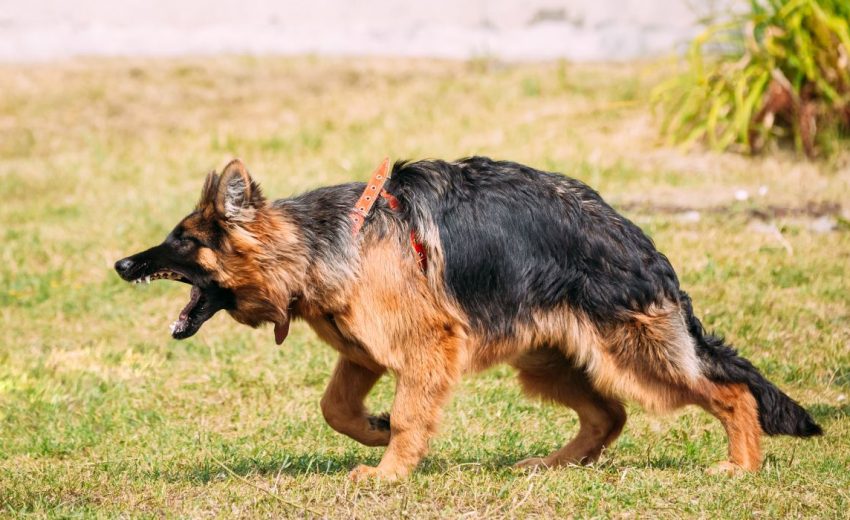




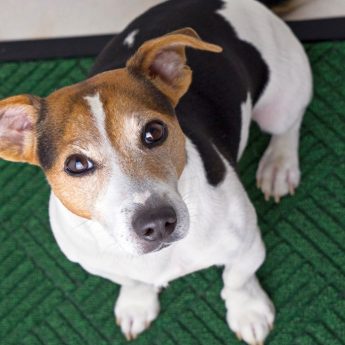
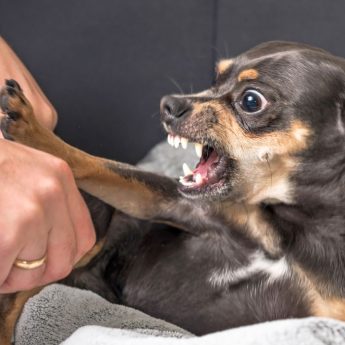
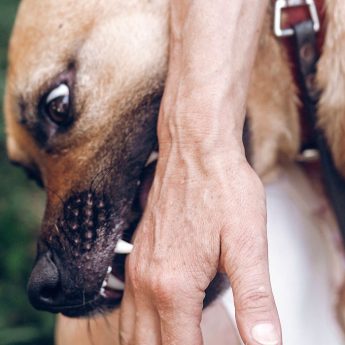
3 Comments
August 11, 2020
Thank you for this information! Will be looking for a trainer in our area – our lab has an issue with one individual, and only that individual. The person lives near us, and interacts with our family. We are hoping to find a resolution to this issue before it escalates.
June 3, 2021
CHOW CHOW!
January 17, 2020
Excellent and important information; I’ll share it with friends that have dogs. NOW, if people will read and apply!!! Rosalyn aka Roz